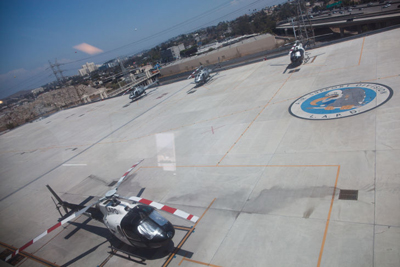
Helicopters parked on the tarmac on the top floor of a facility near the Men's Central Jail in downtown Los Angeles. Anyone who steps on the squadron's logo has to do 50 pushups. (Grant Slater/KPCC)
This is one in a series on the LAPD's helicopter fleet. You can read Part 2 here and Part 3 here.
The nation's largest police helicopter fleet lives in downtown Los Angeles. The L.A. Police Department owns and operates 17 helicopters that cover nearly 500 square miles of the city, from the San Fernando Valley to San Pedro.
Most of them launch and land around the clock from the police department's spacious helipad, located just west of the Los Angeles River.
"The mission is the same. It's just the vehicle is different," says Lt. Phillip Smith, assistant commanding officer at LAPD's Air Support Division.
LAPD's helicopter fleet works in support of the department's ground units. Every day, there are at least two helicopters patrolling the sky in approximately two-hour shifts from 8:30 a.m. until 4:30 a.m. They're looking for criminals, flying over crime hot spots, checking on infrastructure, and providing back-up for ground officers.
RELATED: Photo slideshow of LAPD's air force on KPCC's AudioVision
It works like this: you've got a pilot and a technical flight officer, or TFO. It's the pilot's job to steer the airship and it's the TFO's job to multitask.
I went along on a recent patrol; we lifted off at 8:30 a.m. Our TFO is Greg MacDonald. Once we're airborne, MacDonald tunes in to scanner traffic. Calls come in from the helipad, the nearest LAPD patrol stations and LAPD's central command center. He filters and prioritizes, deciding which calls we will respond to.
The dispatcher puts out a call about a man with a gun running through a south L.A. neighborhood. We zoom from downtown to 112th Street, arriving before any ground units.
The pilot makes a few orbits over a six-block radius circling the house where the call came. MacDonald looks for matching clothing descriptions; he checks the alleys.
The chopper is about four to five hundred feet above ground at this point. MacDonald uses high-powered binoculars to scan over people's fences to make sure no one's hiding in a backyard.
"You know if a suspect was last going seen in a yard, you don't want to put the officer in a bad area," MacDonald says.
After about five minutes of orbits, MacDonald reports back that he doesn't see a suspect or anything out of the ordinary. The ground unit that has arrived reports back the same; it's an "all clear," and we move on.
Lots of calls are also requests to set up and monitor a perimeter (when a chopper positions ground officers to surround a crime scene), track a pursuit, or search for a suspect.
The next call comes over the radio: an officer has a suspect at gunpoint at the corner of 48th and Crenshaw, and requests backup.
MacDonald says this is referred to as an "officer safety call."
"You know, just to make [sure] that there's not some confrontation going on," he says. "If you get somebody that's working by himself and he pulls over a car just for a traffic violation and something happens and it turns into an altercation and he can't get to his radio," the chopper can provide support.
Providing backup is a big part of the helicopters' job. This time the other helicopter on patrol takes the call.
As our patrol flies over the Hollywood Hills, flight officer MacDonald spots something from the air. As we fly near the Hollywood sign, a man messes with the metal gate.
MacDonald gets on the loud speaker and warns the man he's trespassing. It's enough to spook him; he climbs back into his car and drives away.
Our pilot, Kevin Cook recalls orbiting over a perimeter and seeing a man "smash the passenger window of [a] car and reach down in there and [take] something in his left hand and [start] walking away briskly."
But it's rare for a helicopter crew to observe a crime from the air. Most chopper activity involves providing backup and monitoring crime scenes. And many patrols are uneventful.
So it goes with our patrol. Still, the department insists the helicopters provide an invaluable service.











